2020 Ford Puma review - small SUV's surprise package
Love them or hate them, small SUV/crossover vehicles are a huge deal for car makers and the B segment in particular offers a rich market to exploit, hence the arrival of the Ford Puma.
The more observant reader will have spotted that Ford already sells a B-segment SUV. Sadly, the Puma isn’t a replacement for the disappointing EcoSport but is intended to sit above it in the Ford range as a sportier, more high-end crossover-type vehicle.
Advertisement
Hide AdAdvertisement
Hide AdIt’s facing off against the likes of the Nissan Juke, Renault Captur and VW T-Cross in the “fun, funky and front-wheel-drive” market offering eye-catching looks, lots of the latest tech and, in the Puma’s case claims of superior practicality.
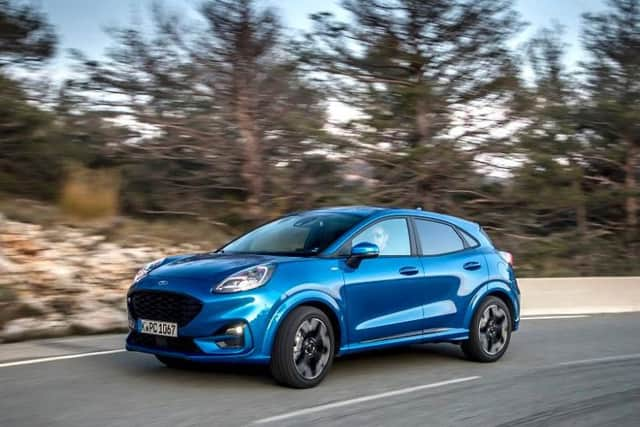

The brand-new Puma is based on the same platform as the current Fiesta but to make this more than a jacked-up, reskinned version of that it’s had its Weetabix and grown up a bit.
Practicality
Compared with the Fiesta, the Puma is taller, longer, wider, with more space for passengers and luggage. It is 15cm longer, 6cm wider and a ride height lift is supplemented by a higher roofline and higher seat position to emphasise its crossover nature. Ford claims it’s capable of carrying five but that’s optimistic. The longer wheelbase has helped create extra rear legroom but it’s still not exactly spacious and although the track is as wide as a Focus that doesn’t translate to cabin space, and the rear bench is only really wide enough for two.
But Ford’s claims of the Puma being the most practical car in its class extend beyond passenger space. First off, it’s got a bigger boot than any rival (456l), and the opening is wide and square, so it’s easy to load with junk from Ikea. It’s also got a multi-level boot floor to create a flat load space, a clever arrangement to move the parcel shelf completely out of the way and useful features such as a (segment-first) gesture-controlled tailgate to make life easier.
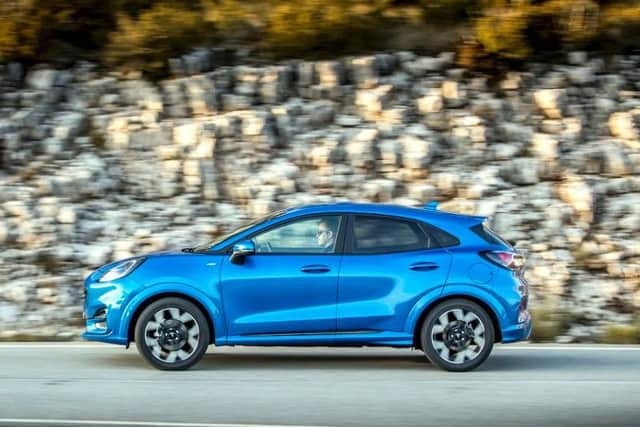

However, Ford’s party piece for the Puma is the Megabox. This turns the space beneath the boot floor (where a spare wheel would once have been kept) into a waterproof, shock-proof extra storage space. At 30cm deep by 76cm wide and 75 long, it adds an extra 80 litres of storage to the space. It’s big enough to take two full-size golf bags upright (or a couple of tall pot plants, for the keen gardeners). It’s also made from durable plastic, is waterproof and features a large drain hole, meaning you can chuck anything from muddy sports gear to manky dogs in the space and then hose it out when you get home, sparing your carpet and upholstery. It’s a genuinely smart solution for all sorts of situations.
Driving
As well as practical, Ford want the Puma to be dynamic, making much of its use of the Fiesta’s platform. In pursuit of this, Ford’s own chief dynamics man himself admitted that a lot of work had to be done to compensate for the car’s increased height. Suspension components are thicker and stiffer and the track has been widened to aid stability. They have clearly worked hard and the result is probably the best handling car in its class,even if it’s not up to Fiesta standards. The steering has the sharpness of the Fiesta and the Puma turns in keenly and can handle some pretty challenging roads without ending up all over the place. ST-Line versions get a sportier suspension setup but the softer Titanium also acquits itself pretty well.
Engines
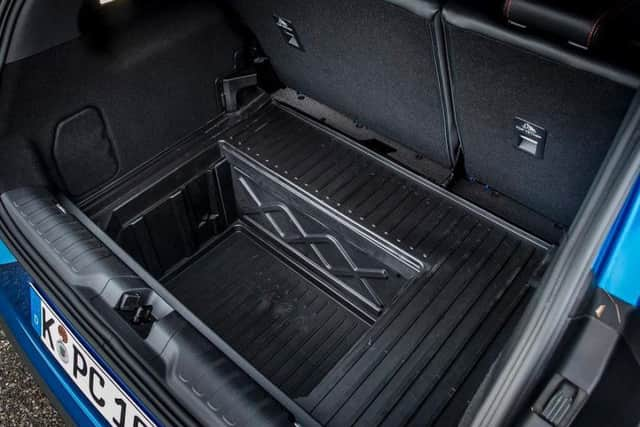

Under the bonnet, there’s a choice of a standard 1.0-litre EcoBoost engine with 125PS or two hybrid versions of the same engine with either 125PS or 155PS. These mild hybrids use an integrated starter motor to offer up to 50NM more torque to aid low speed/low-rev responsiveness while returning claimed best in class economy. The 125PS hybrid’s offers better emissions and economy than the non-hybrid version while the 155 version offers a level of performance often missing from the segment.
All three versions of the engine come with a six-speed manual gearbox but the non-hybrid will get a seven-speed dual-clutch auto later in the year, at the same time as a 120PS 1.5 diesel is added.
Specification
Advertisement
Hide AdAdvertisement
Hide AdAll three versions are also available in all trim levels. At the moment these comprise Titanium, ST-Line and ST-Line X, plus limited run “First Edition ” models, with an ST-Line X Vignale adding some bling shortly after. Prices for Titanium start at £20,545, with the sporty ST-Line an extra £850.
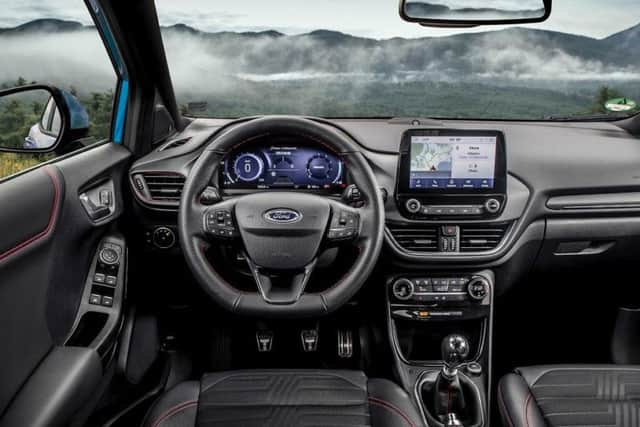

Both specs get 17-inch alloys, an eight-inch touchscreen with navigation, CarPlay and Android Auto, cruise control, wireless phone charging, auto high beam assist, lane assist, AEB and selectable drive modes. A suite of safety systems is also standard, including evasive steering assist, lane keeping, pre- and post-collision braking assist and and cross-traffic alert with active braking. Titanium also gets an opening panoramic roof and segment-first massage seats while ST-Line adds sports suspension, a flat-bottomed steering wheel, sports pedals and a configurable 12.3-inch digital instrument display.
ST-Line X adds 19-inch wheels, a B&O Play sound system and partial leather seats while the First Edition benefits include a driver assistance pack, heated seats and a hands-free powered tailgate.
Such a spec helps put the Kuga up against the best equipped of its rivals and serves to broaden the gap to the EcoSport.
Design
We’ve left the Puma’s looks til last because they are, well, challenging. The internet has said a lot of unkind things about the Puma’s appearance and from certain angles it really isn’t handsome. The bulging headlights and gawping grille are problematic, giving it a slightly surprised, gormless look. But it’s less awkward looking in the metal than in many images and the right colour and trim can help. The ST-Line’s body-coloured wheel arch surrounds and black detailing work better than the Titanium’s black arches and chrome details. And remember, this is entering a segment where the divisive Nissan Juke exists and where individual looks are a selling point.
Thankfully for driver and passengers, the interior is less avante garde, being near-identical to the sensible layout of the Fiesta.
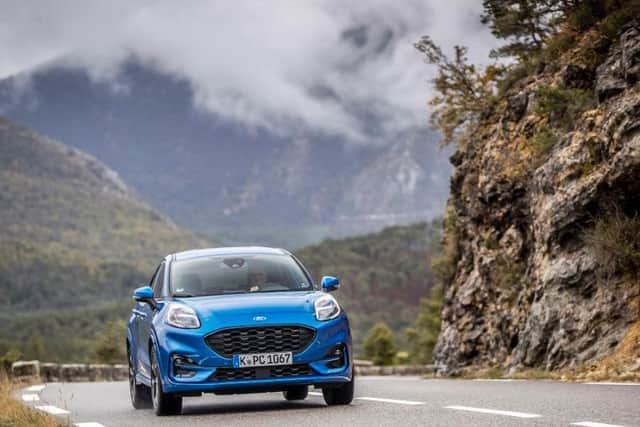

Verdict
Will the Puma set the world alight? Probably not, it is, after all just another B-SUV. But within an often lacklustre segment it brings a superior driving experience and some clever practical touches for buyers who aren’t interested in a regular hatchback.